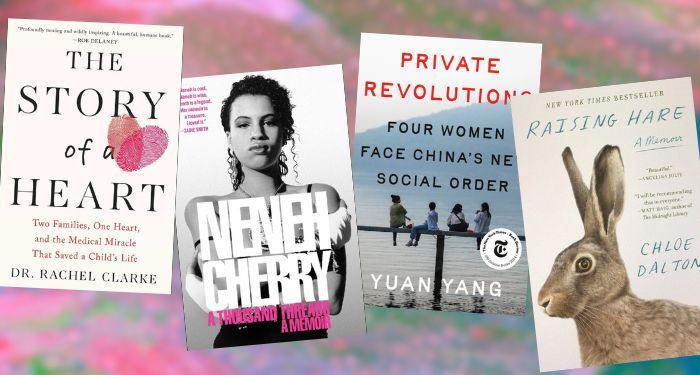Products You May Like
This content contains affiliate links. When you buy through these links, we may earn an affiliate commission.
The Women’s Prize is in its second year of having a nonfiction prize. For this year’s shortlist, the prize’s website states, “The Six books on the 2025 Women’s Prize for Non-Fiction shortlist are united by the power of hope and the necessity of resistance to initiate change.” The shortlist includes:
The winner will be announced June 12th.
Book Riot’s own Kelly Jensen gives the latest updates in book censorship news, including Lawsuit Filed Over LGBTQ+ Book Censorship in South Carolina’s Greenville County Public Libraries. Libraries across the country are losing funding, LGBTQ+ books are being pulled from shelves, and librarian criminalization bills are on the rise.
True Story
Sign up for True Story to receive nonfiction news, new releases, and must-read forthcoming titles.
In January, Rev. Mariann Edgar Budde made headlines for angering President Trump when she asked him to “have mercy” for LGBTQ+ people and migrants. Now she has a two-book deal with Penguin Young Readers. These two books for young people will be based on her book How to Be Brave. The young adult edition will be released on October 25th, and the picture book edition will be released in the summer of 2026.
As it says on the website, “Founded in 1935 by poet and philanthropist Edith Anisfield Wolf, AWBA remains the only national endowed juried prize recognizing books that contribute to our understanding of racism and foster an appreciation of cultural diversity.” The finalists include fiction, nonfiction, poetry, and memoir. The list includes:
- Janice Harrington, Yard Show
- Tessa Hulls, Feeding Ghosts
- John Swanson Jacobs/edited by Jonathan D. S. Schroeder, The United States Governed by Six Hundred Thousand Despots: A True Story of Slavery; A Rediscovered Narrative, with a Full Biography
- Sarah Lewis, The Unseen Truth: When Race Changed Sight in America
- Susan Muaddi Darraj, Behind You Is the Sea
- Emily Raboteau, Lessons for Survival: Mothering Against “the Apocalypse”
- Kiley Reid, Come and Get It
- Danzy Senna, Colored Television
- Adam Shatz, The Rebel’s Clinic: The Revolutionary Lives of Frantz Fanon
- Danez Smith, Bluff
The winner will be announced this fall at the annual Anisfield-Wolf Book Awards ceremony.
That’s it for this week! You can find me over on my substack Winchester Ave or over on Instagram @kdwinchester. As always, feel free to drop me a line at kendra.d.winchester@gmail.com. For even MORE bookish content, you can find my articles over on Book Riot.
January 16, 2025, marked the 100th anniversary of the publication of F. Scott Fitzgerald’s novel The Great Gatsby. The New York Public Library celebrated with a party, following a special performance of the Broadway musical adaptation of the novel. Simon and Schuster recently released a new audiobook with an introduction by Jesmyn Ward.
The novel’s theme of reinventing oneself is timeless. The ideas of living a lie by reinventing yourself and wealth making people callous are equally resonant today. How did this novel become so influential, especially on other American novels, and a fixture on high school syllabi? Was it always a bestseller? What aspects of Gatsby hold up, and which ones have aged terribly?
Fitzgerald’s original title for The Great Gatsby was Trimalchio in West Egg. I think the publisher was right to change it. Trimalchio is a character from the ancient Roman work The Satyricon. Combined with the fictional West Egg neighborhood, this reference is cryptic. Gatsby is now an icon in his own right. He doesn’t need a classical allusion for us to notice the theme of excessive wealth.
In a 2014 NPR interview, Maureen Corrigan, the author of So We Read On: How The Great Gatsby Came to Be and Why It Endures, explained how Gatsby became popular. Initial reception was mixed, ranging from the headline “Fitzgerald’s Latest a Dud,” to Modernist poets like T. S. Eliot saying they loved it. When Fitzgerald died in 1940, Gatsby was unpopular (but not out of print). A few years later, it was republished for US service members in World War II, and 123,000 copies were given to members of the military through the Armed Services Editions.
After World War II, Gatsby was no longer an obscure book with mixed reviews. It was considered a classic and became a staple of countless high school syllabi. Constance Grady wrote that Gatsby was ideal for many 20th and early 21st-century English teachers’ emphasis on New Criticism. It’s a great choice for close readings of short passages and analyzing symbolism. However, historical context is also crucial and should never be downplayed, especially in terms of bias.
The Great Gatsby possibly condemns white supremacist theories but uses racist language elsewhere. Tom Buchanan reads white supremacist books and goes on racist rants. Daisy mocks him for this. It’s easy to read this as condemning Tom’s overall bigotry. However, Fitzgerald also expressed racist and antisemitic views in real life.
Sign up to become an All Access member for only $6/month and then click here to read the full, unlocked article. Level up your reading life with All Access membership and explore a full library of exclusive bonus content, including must-reads, deep dives, and reading challenge recommendations.
